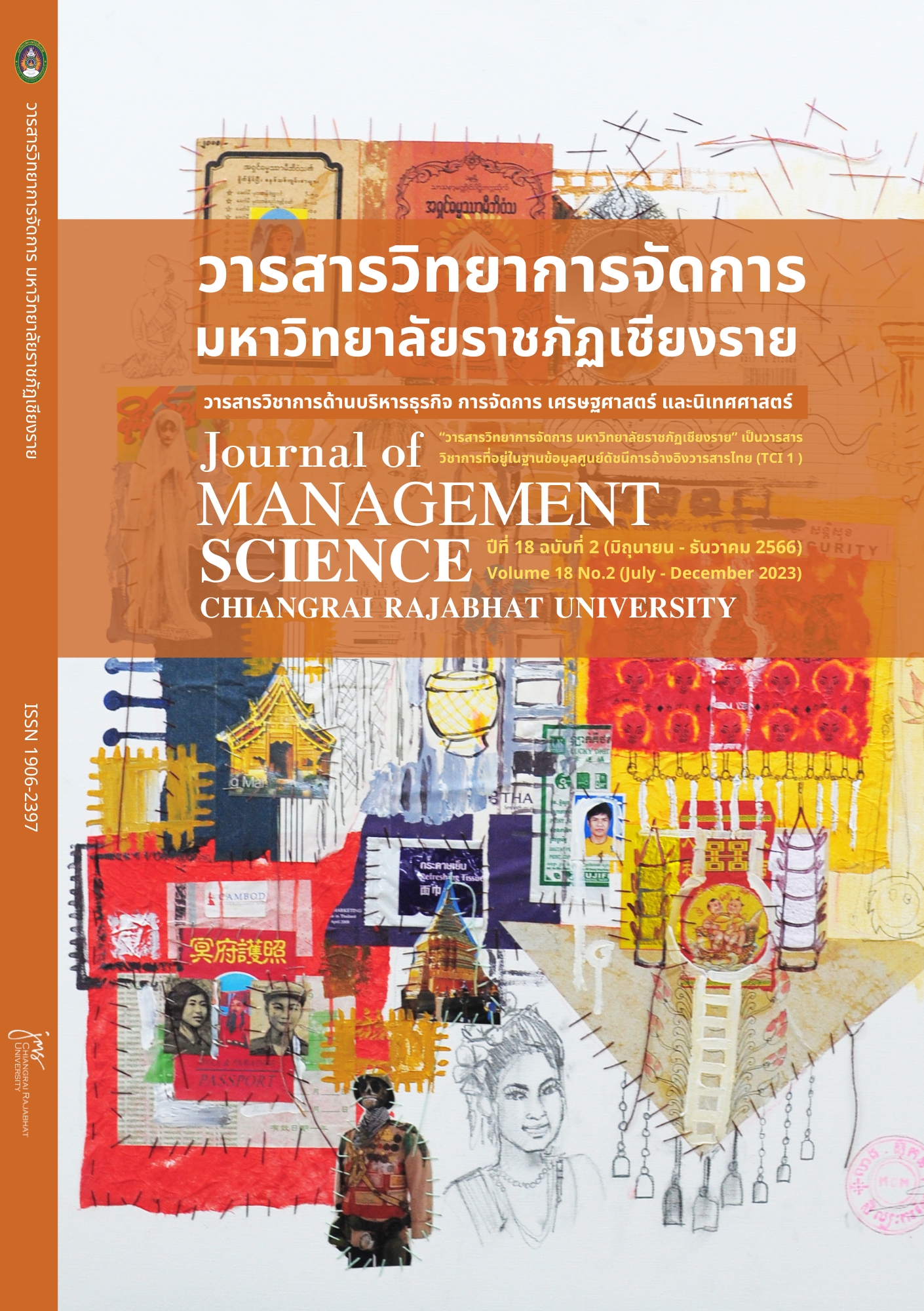ปัจจัยที่ส่งผลต่อพฤติกรรมในภาวะปกติแบบใหม่ (New Normal) และความสนใจการท่องเที่ยวเชิงสร้างสรรค์ในภูมิภาคเอเชียใต้ของนักท่องเที่ยวชาวไทย
Main Article Content
บทคัดย่อ
บทความวิจัยชิ้นนี้ศึกษาปัจจัยที่ส่งผลต่อพฤติกรรมในภาวะปกติแบบใหม่ (New Normal) และความสนใจการท่องเที่ยวเชิงสร้างสรรค์ในภูมิภาคเอเชียใต้ของนักท่องเที่ยวชาวไทย โดยใช้วิธีการวิจัยเชิงสำรวจ ผ่านแบบสอบถามทางออนไลน์จากกลุ่มนักท่องเที่ยวชาวไทยจำนวน 391 คน แบ่งเป็น 1) กลุ่มผู้มีประสบการณ์เดินทางท่องเที่ยวในประเทศใดประเทศหนึ่งของภูมิภาคเอเชียใต้มาแล้ว และ 2) กลุ่มผู้ที่ยังไม่เคยเดินทางไปแต่มีความตั้งใจหรือสนใจที่จะเดินทางไปท่องเที่ยวภายใน 5 ปีถัดจากนี้ ผลการศึกษาพบว่าปัจจัยด้านลักษณะเด่นของจุดหมายปลายทางทางการท่องเที่ยวและการให้บริการทางการท่องเที่ยวต่าง ๆ ที่เกี่ยวข้อง เป็นปัจจัยที่นักท่องเที่ยวให้ความสำคัญสูงที่สุด โดยปัจจัยทางสังคมมีความสำคัญเป็นลำดับสุดท้าย ในความคิดเห็นของนักท่องเที่ยวชาวไทยทั้งสองกลุ่ม ในด้านความสนใจการท่องเที่ยวเชิงสร้างสรรค์พบว่านักท่องเที่ยว ทั้งสองกลุ่มมีความแตกต่างด้านความสนใจใน 5 กิจกรรม อย่างมีนัยสำคัญทางสถิติที่ระดับ .05 การสร้างโอกาสของการท่องเที่ยวเชิงสร้างสรรค์ของภูมิภาคเอเชียใต้ในกลุ่มนักท่องเที่ยวชาวไทย จึงควรที่จะ (1) ออกแบบการสื่อสารตามประสบการณ์การท่องเที่ยว (2) ดึงดูดใจนักท่องเที่ยวที่มีประสบการณ์ด้วยเส้นทางและประสบการณ์ใหม่ ๆ และ (3) เย้ายวนใจนักท่องเที่ยวกลุ่มใหม่ด้วยประสบการณ์น่าประทับใจและ “Instagrammable”
Article Details

This work is licensed under a Creative Commons Attribution-NonCommercial-NoDerivatives 4.0 International License.
ทัศนะและข้อคิดเห็นของบทความที่ปรากฏในวารสารฉบับนี้เป็นของผู้เขียนแต่ละท่าน ไม่ถือว่าเป็นทัศนะและความรับผิดชอบของกองบรรณาธิการ
References
Ministry of Tourism. (2019). India Tourism Statistic 2019. Retrieved May 20, 2021, from http://tourism.gov.in/sites/default/files/2020-04/India%20Tourism%20Statistics%202019.pdf
Madden, C. (2020). Euromonitor predicts digital, frictionless future for travel industry. DFNI Frontier. Retrieved June 25, 2021, from https://www.dfnionline.com/latest-news/euromonitor-predicts-digital-frictionless-future-travel-industry-01-07-2020/
NapoleanCat. (2021). Instagram users in Thailand: August 2021. Retrieved November 30, 2021 from https://napoleoncat.com/stats/instagram-users-in-thailand/2021/08/
National Bureau of Statistics. (2019). Table 10.1: Flow of Tourists by Nationality, 2016 – 2019. Retrieved May 25, 2021, from http://statisticsmaldives.gov.mv/yearbook/2020/wp-content/uploads/sites/7/2020/09/10.1.pdf
Nunnally, J. C. (1978). Psychometric theory (2nd ed.). New York: McGraw-Hill.
Pearce, P. L. (2005). Tourist behaviour: Themes and conceptual schemes. Clevedon, England: Channel View Publication
Proyrungroj, R. (2015). Tourist Behaviour [in Thai]. Bangkok: Odeanstore.
Richards, G. (2011). Creativity and tourism: the state of the art. Annals of Tourism Research, 38, 1225-1253.
Richards, G. (2013). Tourism development trajectories: From culture to creativity? In M. Smith & G. Richards (Eds.), The Routledge handbook of cultural tourism (pp.297-303). Oxon: Routledge.
Schmöll, G. A. (1997). Tourism Promotion: Marketing background, promotion techniques and promotion planning methods. London: Tourism International Press.
Silpjaru, T. (2005). The research and statistical analysis with SPSS. [in Thai]. Bangkok: V Interprint Co., Ltd.
Siwamokelukkana, J. & Suebbook, P. (2020). Thinking Corner and Future Tourism. Creative Thailand. Retrieved July 15, 2021, from https://www.creativethailand.org/article/howto/32512/th?fbclid=IwAR1amfuJXH8QeZCbwdw4kZ9WbiAEvQaoC7wx8jM9ufhtf63CThAsJyx6ZDs#RC-July-20
Sri Lanka Tourism Development Authority. (2019). Annual Statistical Report 2019 (Provisional Release). Retrieved May 21, 2021, from https://sltda.gov.lk/storage/common_media/AAnnual%20Statistical%20Report%20new%202109%20Word3889144215.pdf
Swarbrooke, J. & Horner, S. (2007). Consumer Behaviour in Tourism (2nd ed). Oxford, UK: Elsevier.
Tourism Council of Bhutan. (2019). Bhutan Tourism Monitor 2019. Retrieved May 23, 2020, from https://www.tourism.gov.bt/uploads/attachment_files/tcb_ K11a_BTM%202019.pdf
United Nations Educational, Scientific and Cultural Organization. (n.d.). World Heritage List. Retrieved August 22, 2020, from https://whc.unesco.org/en/list/&order=region
United Nations World Tourism Organization. (2019). International Tourism Highlights, 2019 Edition. Retrieved July 5, 2021, from https://doi.org/10.18111/9789284421152
World Economic Forum. (2019). The Travel and Tourism Competitiveness Report 2019: Travel and Tourism at a tipping point. Retrieved December 21, 2021, from http://www3.weforum.org/docs/WEF_TTCR_2019.pdf
Zuluaga, D. & Guerra, D. (2021). A typology of creative travelers in Bogota, Columbia: The experience of 5 Bogota. In N. Duxbury, S. Albino, and C.P. Carvalho (Eds), Creative Tourism: Activating Cultural Resources and Engaging Creative Travellers (pp 15-25), Oxfordshire, CABI.

